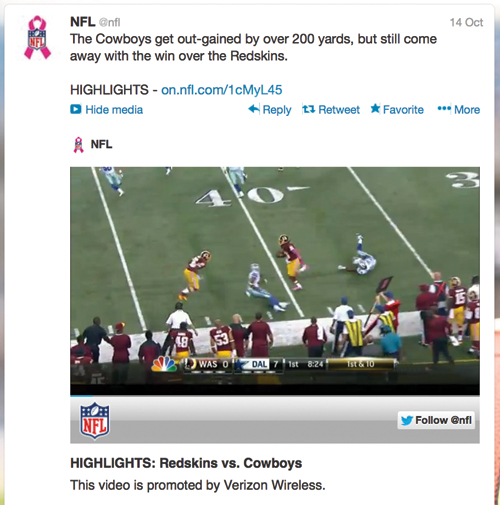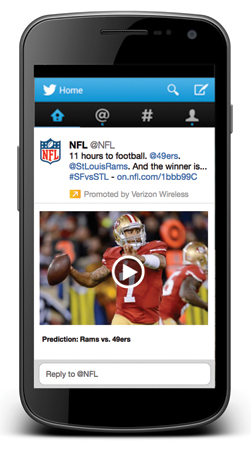On Oct. 13, the Boston Red Sox loaded the bases in the eighth inning against the Detroit Tigers in Game 2 of the American League Championship Series. At the same time, the Washington Redskins were driving into Dallas Cowboys territory during the fourth quarter of “Sunday Night Football.”
The Red Sox-Tigers game was on Fox; the Redskins-Cowboys game was on NBC. But they were both all over Twitter, amassing more than 1.1 million combined tweets and tens of millions of total impressions, illustrating why the social media company has become one of the most talked about brands in sports media.
In addition to all the Twitter activity, both games’ TV viewership saw significant increases over the comparable games from last year, with “Sunday Night Football” logging more than 22 million viewers and Fox’s ALCS game averaging more than 8 million.
This is Twitter’s main selling point these days. Its executives, led by newly hired head of sports partnerships Geoff Reiss, have met with nearly every sports league over the past couple of weeks with the promise that Twitter activity boosts TV ratings.
“When you get people to tweet about your show, the ratings will go up,” said Omid Ashtari, Twitter’s head of sports and entertainment, speaking earlier this month at SportsBusiness Journal’s Sports Marketing Symposium in New York.
Twitter’s recent high-profile deal with Nielsen to create a social media-influenced set of TV ratings seeks to further the notion that Twitter can help the traditional business of television. Some league and TV network executives, however, aren’t so sure.
“There are a lot of reasons somebody may be watching something, or tweeting something, and it might be a bit of a leap to immediately connect the two,” said Bob Bowman, MLB Advanced Media president and chief executive. “And while it may be often true that somebody tweeting about a show is watching, it’s not necessarily so. I think the main goal needs to be finding the right way to really measure true engagement across each platform.”
That hesitancy has not stopped leagues, including MLB, from cutting deals with Twitter, which is preparing an initial public offering. Leagues may not know if Twitter actually boosts TV ratings, but they are eager to be part of the Twitter conversations occurring around their games.
Twitter executives like to cite a stat that says sports accounts for 1 percent of TV programming but makes up more than half of Twitter conversations — something that was evident as Red Sox designated hitter David Ortiz hit a grand slam to tie the ALCS game, and Redskins quarterback Robert Griffin III threw an end zone interception to seal the Cowboys’ win.
During even higher profile sports events, such as the Super Bowl, Final Four, or Game 7 of the NBA Finals or World Series, sports can represent nearly 90 percent of all TV-related tweets. The question is whether Twitter eventually will bring real media revenue to leagues, or whether the leagues will consider it more of a marketing expense.
“For us right now, it’s about managing the conversation and creating the national conversation around hockey so fans can better understand what’s going on around the league,” said John Collins, the NHL’s chief operating officer. “Just because there’s not real revenue today doesn’t mean that we don’t think there will be.”
It’s clear that executives in Twitter’s San Francisco headquarters are bullish about using sports to grow their business. The popularity of sports is why the company signed a large-scale deal last month with the NFL worth an undisclosed, low-eight-figure sum. The deal embeds football highlights, fantasy content and other material into the microblogging site and allows the league to partner on Twitter’s new Amplify advertising platform. Existing league sponsors Verizon and McDonald’s have signed on as advertisers in the venture.
For Twitter, these types of partnerships are natural, though plenty of others won’t come with nearly the type of ad dollars connected to the NFL’s effort. The company has sought to position itself as a trusted ally to the television, sports and entertainment industries.
For leagues, these deals aren’t strictly about the content — at least not yet. Leagues are experimenting with the platform more as a marketing opportunity than as a place where they can extract rights fees. Leagues like the idea of reaching casual fans through Twitter, and they are curious to see if Twitter’s claim that it can help drive TV ratings is accurate.
Twitter uses a Nielsen study from August that found 29 percent of 221 broadcast shows, across various genres, saw significant lift in their live ratings from heightened Twitter activity. The research has resonated with leagues that see revenue potential down the line.
 |
| The NFL sees new partner Twitter driving both awareness and consumption. |
“We think it ultimately not only drives incremental engagement and consumption, it will drive incremental awareness for our content, will drive incremental tune-in for our games,” said Hans Schroeder, NFL senior vice president of media strategy and development. “There’s a lot of good trends there to think that this is all additive from a second-screen experience about driving content to all those other places and back to NFL Mobile on a handset, which is another key area for us. We think this hopefully builds value for all our sets of [media] rights and drives overall consumption around NFL content.”
The NFL signed its Twitter deal for one season, giving the league an opportunity to experiment and evaluate. But given the league’s massive shadow upon the rest of the sports industry, its Twitter experimentation is being watched closely, particularly by its network and corporate partners.
“This [NFL] deal is another step forward with how [Twitter is] going to get involved with sports,” said Blaise D’Sylva, Anheuser-Busch vice president of media, sports and entertainment marketing. “It’s only going to grow.”
The recent flurry of activity from Twitter follows a similar push last spring, when it debuted Amplify. Among the initial, sports-related partners of Amplify were ESPN, the NBA, Turner Sports, MLB Advanced Media, the PGA Tour, Fox Sports and Sports Illustrated parent Time Inc.
“You have to understand the power of [Twitter] and its correlation to live events,” said Adam Zimmerman, marketing president at CSE. “TV plus social is better. It is a part of how people are engaging with content.”
Bowman said MLBAM’s work with Amplify has been successful so far. On several occasions, baseball experimented with streaming live games inside of Twitter, such as the Futures Game during All-Star break. “What we’re doing is trying to build engagement as opposed to being a direct economic thing, where we’re trying to get fans to click and buy something,” he said.
Twitter and the sports leagues believe the launch of a service like Amplify creates advertising opportunities on Twitter and helps leagues figure out how to generate meaningful revenue through social media.
“I used to joke around that monetizing social is to be akin to splitting the atom in its difficulty. I can tell you that’s no longer the case,” said Melissa Brenner, the NBA’s senior vice president of marketing. “Partners are specifically asking to activate our audience to reach their consumers. Increasingly, it’s a viable means for us to include our marketing partners and grow our revenue collectively for the NBA as a league and our teams and players.”
This marks a change from when the NBA first started working with Twitter, in 2009, Brenner said. That’s when the league treated Twitter as an opportunity to get people to tune in to close games.
“What we found is that through Twitter it’s not just tune in, but it’s also about telling players’ stories both on and off the court,” she said. “We’re finding all these creative ways where you could engage fans beyond tune-in.”
More similar Twitter-league partnerships are expected to soon arrive. The NHL is talking to the company about developing further ways to push national conversation around hockey, which traditionally has been very regional in its fandom. More specifically, the league and corporate partner Coors are working on social media executions for the coming debut of the Coors Light Stadium Series of outdoor games.
“Our partners and sponsors are looking for a social media play that can help drive a conversation around those platforms,” said the NHL’s Collins. “Sometimes they look to us for that and we can provide it. Sometimes they want to provide it and use their own resources to drive a specific program they have.”





